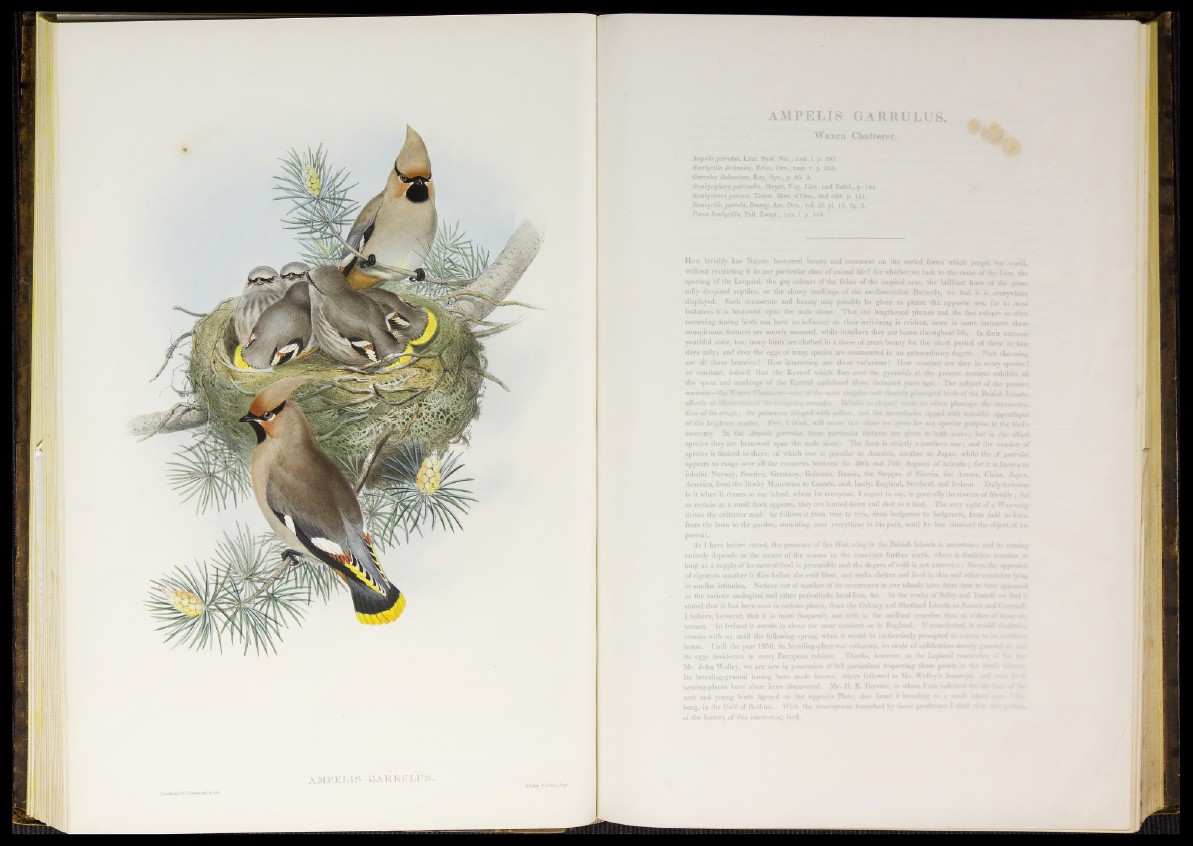
AMPE L I S GARRULUS.
Waxen Chatterer.
Ampelis garrulus, Linn. Syst. Nat., tom. i. p. 297.
Bombycilia Bohémica, Bliss. Om., tom. v. p. 333.
Garrulus Bohemicus, Ray, Syn., p. 85, A.
Bombyciphora polioccelia, Meyer, Vog. Liev. und EsthL, p. 1(M.
Bombycivora garrula, Temm. Man. d’Orn., 2nd edit. p. 124.
Bombycilla garrula, Bonap. Am. Om., vol. iii. pi. 16. fig. 2.
Paras bombycilla, Pall. Zoogr., tom. i. p. 548.
How lavishly has Nature bestowed beauty and ornament on the varied forms which people the world,
without restricting it to any particular class o f animal life ! for whether we look to the mane of the Lion the
spotting o f the Leopard, the gay colours o f the fishes o f the tropical seas, the brilliant hues o f the generally
despised reptiles, o r the showy markings o f the swallow-tailed Butterfly, we find it is everywhere
displayed. Such ornaments and beauty may possibly be given to please the opposite sex, for in most
instances it is bestowed upon the male alone. That the lengthened plumes and the fine colours so often
occurring among birds can have no influence on their well-being is evident, since in some instances these
conspicuous features are merely seasonal, while imothers they are borne throughout life. In their extreme
youthful state, too, many birds are clothed in a dress of great beauty for the short period of three or four
days only; and even the eggs of many species are ornamented in an extraordinary degree. How charming
are all these beauties! How interesting are these variations! How constant are they in every species !
so constant, indeed, that the Kestrel which flies over the pyramids a t the present moment exhibits ail
the spots and markings o f the Kestrel embalmed three thousand years ago. The subject of the present
memoir—'the Waxen Chatterer-~<*m' <>t the most .singular and chastely plumagcd birds o f the British Islands,
affords an HnMrMUwsf the foregoing remarks. Behold if* elegant crwt, it« silken plumage, the ornamentation
o f its wings; the primaries fringed with yellow, and the secondaries tipped with wax-like appendages
of the brightest scarlet. Few, I think, will assert that these are given for any specific purpose in the bird’s
economy. In the Ampelis garrulus, these particular features arc given to both sexes; but in the allied
species they are bestowed upon the male alone. The form is strictly a northern o n e ; and the number of
species is limited to three, o f which one is peculiar to America, another to Japan, while the A . garrulus
appears to range over all the countries between the 40th and 70th degrees o f latitude; for it is known to
inhabit Norway, Sweden, Germany, Bohemia, Russia, the Steppes o f Siberia, the Amoor, China, Japan,
America, from the Rocky Mountains to Canada, and, lastly, England, Scotland, and Ireland. Truly welcome
is it when it comes to our island, where its reception, I regret to say, is generally the reverse o f friendly: for
as certain as a small flock appears, they are hunted down and shot to a bird. The very sight of a Wax-wing
drives the collector m ad : he follows it. from tree to tree, from hedgerow to hedgerow, from field to lawn,
from the lawn to the garden, stumbling over everything in his path, until he has obtained the object of his
As I have before stated, the presence of the Wax-wing in the British Islands is uncertain; and its coining
entirely depends on the nature o f the season in the countries further north, where it doubtless remains as
long as a supply o f its natural food is procurable and the degree of cold is not excessive; for air the approach
of rigorous weather it flies before the cold blast, and seeks shelter and food in ibis and other countries lying
in similar latitudes. Notices out o f number o f its occurrence in our islands have from time to rime appeared
in the various zoological and other periodicals, local lists, &c. In the works of Selby and Yarrell we find it
stated that it has been seen in various places, from the Orkney and Shetland Islands to Sussex and Consnril
I believe, however, that it is more frequently met with in the midland counties than at either of those extremes.
In Ireland it occurs in about the same numbers as in England. If unmolested, jt would duubtfc*»
remain with us until the following spring, when it would be instinctively prompted to return to wmfcwi
home. Until the year 1856, its breeding-plaee was unknown, its mode of nidification merely guessed *t.
its eggs desiderata in every European cabinet. Thanks, however, to the Lapland research«“* of the h*i
Mr. John Wolley, we are now in possession o f full particulars respecting these points in the hi? - . ■
Its breeding-ground having been made known, others followed in Mr. Wollcy’s footsteps, jj
nesting-places have since been discovered. Mr. H. E. Dresser, to whom I am indebted for Uw i
nest and young birds figured on the opposite Plate, also found it breeding on a sinaH is
borg, in the Gulf o f Bothnia. With the descriptions furnished by those gentlemen I dm
o f the history o f this interesting bird.